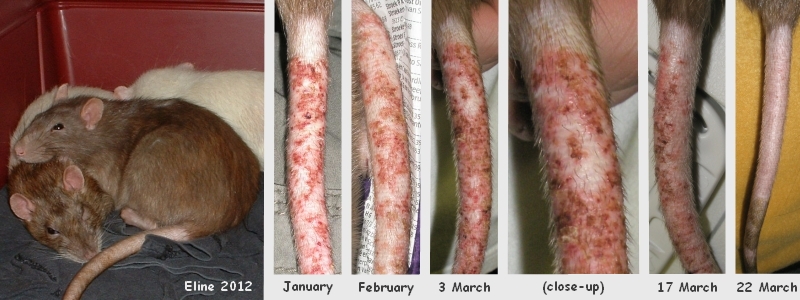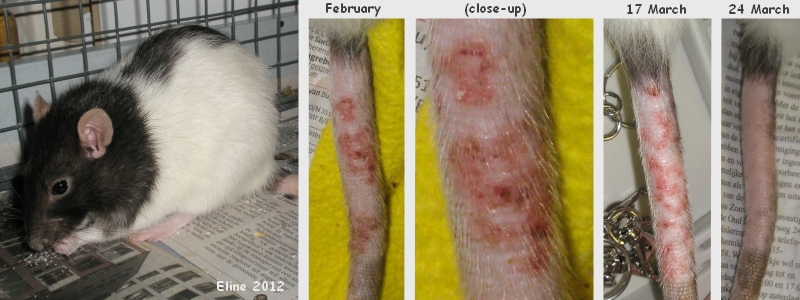Figure 1: Dermatitis (origin unknown) with scabbing of tails on two adult female rats (Mus and Knofje).
Case history and photos
History
Mus is a mink-coloured intact female rat with ruby eyes. She was bought at a petstore. Her estimated date of birth is January 2006.
Knofje is a black hooded intact female rat. Her approximate date of birth is December 2004. Knofje was the runt of the litter and was rejected/ignored by her mother on several occasions. However, their keeper persisted in returning her to the litter, where she was allowed to nurse. Knofje remained a very small rat throughout her life: as an adult she weighed around 320g.
Initially, Mus and Knofje lived in different rat groups, in different households.
Note, however, that their keepers are acquainted and often visit each other.
In July/August 2007 both rat groups suffer from a lice infestation, which is treated successfully with topical ivermectin.
In January 2008, due to the passing away of the last of her cagemates, Knofje is added to Mus’s rat group, which at that time consists of Mus and two other adult females, one of which is Knofje’s mother (Chocolate Chip, agouti hooded).
Clinical Signs
In July 2007 two small scabs were noticed on Mus’s tail, but nothing was thought of them.
By December 2007 Mus’s tail has a lot more scabs and by 12 January 2008 – when the rat sitter visits and handles the rats* – there are several irritated-looking scabby areas on Mus’s tail, starting about 1cm from the base of her tail and continuing for about 7cm. A small area a few centimeters away from her tail tip is also affected.
Knofje’s tail is also affected, although to a lesser extent: she has scabby areas on her tail for for about 5cm, also starting about 1cm from the base of her tail.
Both Mus and Knofje are seen nibbling/grooming their tail.
The two cagemates’ tails do not appear to be affected.
* Note that, shortly after the visit, the rat sitter develops a fungal infection on her shoulder.
Diagnosis
Initially, treatment is started by the rat sitter, while Mus & Knofje’s keeper is on holiday, in the assumption that the girls have a bacterial tail infection. A few days later a vet is consulted, who thinks the cause is either mites and/or a bacterial infection. (Note that a possible connection to the rat sitter’s own fungal infection is not made at this time.)
Treatment
On 23 February* treatment is started against a possible bacterial infection, by applying Clindobion cream (clindamycine 10mg/g) twice a day to the affected areas on Mus, Knofje and Chocolate Chip’s tail (by this time “Chip” had also developed a few small scabs on her tail).
On 28 February treatment against a possible mite infestation is added: Mus, Knofje and Chocolate Chip receive injectable ivermectin and Merel (the other female cage-mate) receives topical ivermectin. This treatment is repeated (topically) on 9 March and 18 March. The day after each application the cage is cleaned thoroughly: all the fabrics are washed and all the cardboard houses are discarded.
* Note that the rat sitter starts treatment against her own fungal infection around the same time; the gp-prescribed cream has positive effects within a few days.
Follow-up
Initially, the Clindobion cream makes Mus and Knofje’s tails seem “calmer/dryer”: the irritated-looking red areas are replaced by brown scabs.
However, by 29 February Mus’s tail is covered in so many reddish-brown scabs that it actually looks worse than when the treatments started. Knofje’s tail seems quite “red” (possibly due to scab removal). Nevertheless, the treatment is continued.
On 2 March healthy pink skin becomes visible underneath Mus’s brown tail scabs; the day after, a distinct ring-like lesion is observed on her tail. On 4 March most of the scabs on Knofje’s tail are gone, having been replaced by healthy pink skin. The girls’ tails continue to improve and by 12 March they both look considerably less irritated.
However, the tails continue to have “red” areas and scabs, and especially Knofje’s tail has several distinct ring-like lesions.
On 18 March the vet is consulted again. In an attempt to break the cycle of itch-groom-lesion-itch-groom-etc, the advice is to switch to Hydrocortiderm cream (neomycine sulphate & prednisolone acetate) and apply it twice a day to the affected areas, letting it “soak in” for 10 minutes. Neither Mus nor Knofje objects to the cream application and they do not lick or groom their tails.
Outcome
The Hydrocortiderm cream shows rapid improvement: on 21 March Mus’s tail has healed completely, and on 24 March Knofje’s tail has healed completely.
In April the rats return to their keeper. Unfortunately, a few weeks later the tail scabs recur, both on Mus and – to a lesser degree – Knofje’s tail. When the Hydrocortiderm cream is applied it has rapid positive effects. However, the scabs tend to return again after awhile (e.g., in July Mus once again has a few scabs on her tail).
The exact cause of the tail scabs remains unknown. Neither Mus’s keeper nor Knofje’s previous keeper developed a fungal infection; it did not recur in the rat sitter, either.
Photos
 The first photo shows Mus (mink) cuddling with her cage-mates Chocolate Chip (agouti hooded) and Merel (PEW). The “January” photograph was taken during the rat sitter’s visit. The “February” photo was taken a few days after starting the Clindobion treatment, which made Mus’s tail looks somewhat “calmer/dryer”. Ivermectin treatment was initiated on this day. The following photograph (and its close-up) were taken a few days later; they show the apparent worsening of Mus’s tail condition, as well as a distinct ring-like lesion. By 17 March Mus’s tail had improved considerably. The switch to Hydrocortiderm cream was made on this day. The final photo shows a healed tail: the pink areas were previously covered in scabs (the remaining brown areas are simply dirty). |
 The first photo shows Knofje’s petite size. The “February” photo (and its close-up) were taken a few days after starting the Clindobion treatment; they show distinct ring-like lesions. By 17 March Knofje’s tail had improved, but the ring-like lesions remained present (note that they appear to have “enlarged/widened” over time). The switch to Hydrocortiderm cream was made on this day. The final photo shows a healed tail: the pink areas were previously covered in scabs (the remaining brown areas are simply dirty). |
Pet keeper: Eline
Case history and photos courtesy of Cyzahhe


